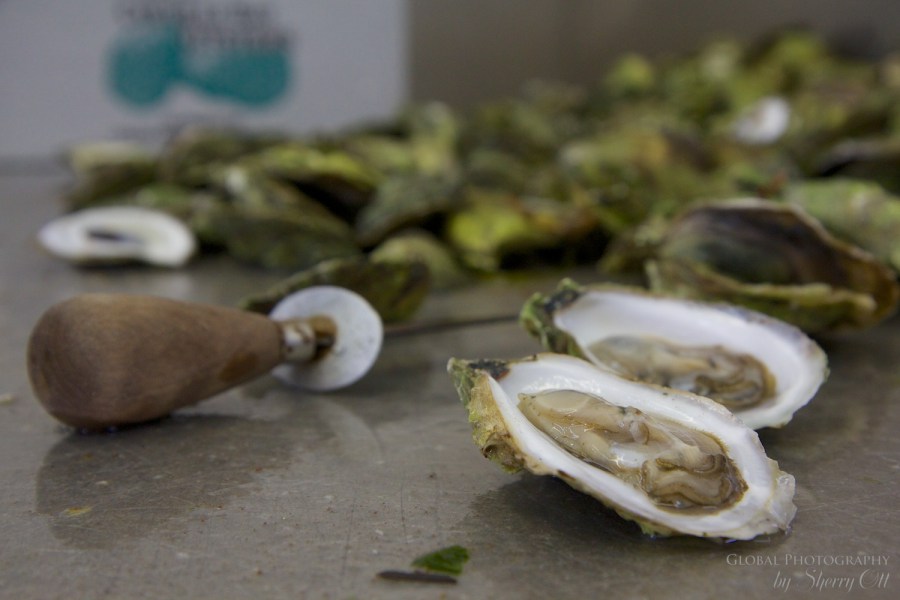
He held the aqua-green rough shell in his hand with a rubber glove, and with the other hand he swiftly pried the shell open making it look easy, yet I know from experience that oyster shucking is not easy.
The top shell popped off and he handed me the bottom shell with a perfectly plump oyster. I smiled, looked at my dad as we ‘clinked’ our oyster shells and did a ‘bottoms up’ move and I let the oyster slide into my mouth. No sauce, just pure oyster. Unlike most people, I actually like to taste my oyster, so I chewed it up to enjoy the delicious briny flavor. “Do you want another?” Johnny asked ready to shuck more.
“Of course, how many opportunities do you get to have fresh oysters for breakfast?” I replied. Yes, oysters for breakfast, it may sound strange, but much like eating fresh sushi in Japans’s Tsukiji Fish Market for breakfast, you can’t pass up fresh oysters at Colville Bay Oyster Company – never, never, never – even at 9:00AM. After all, if you are looking for things to do in PEI, then eating seafood really should be at the top of your list – at any time of day.
“We were flying by the arse of our pants. We weren’t too scientific, “ owner Johnny Flynn described the startup of the Colville Bay Oyster Company 22 years ago. Like many seamen I had met in PEI, Johnny started as a Lobster and Cod fisherman, but due to the cyclical and unpredictable nature of that business, he decided that he wanted another business that was a bit more predictable and brought in money year round. They decided on aquaculture and harvesting oysters.
One problem, they really knew nothing about Oyster farming.
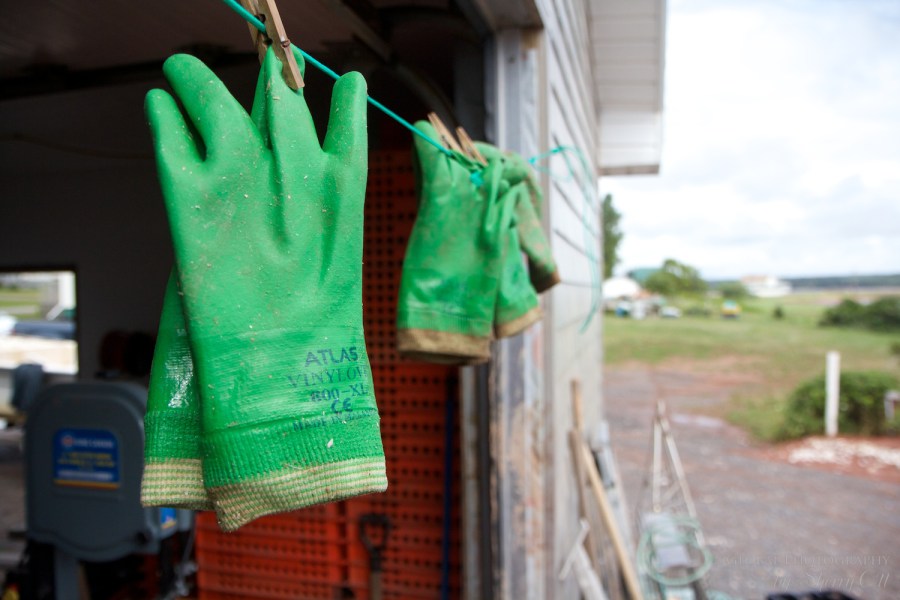
A Story Book Beginning
Johnny’s family history read like the Anne of Green Gables Novels that made PEI famous. Johnny’s father was an orphan, and he was ‘given’ to a family who needed a farm boy to help out around the farm. The mother felt like it was all just too much to take on so she said that either they boy (Johnny’s father) or the dog would have to go. So they shot the dog, and his father was raised on a farm near Souris PEI.
Johnny pointed across the street to the little one room schoolhouse. “That’s where I grew up, “ he said, “and I never could’ve imagined 57 years ago that this would be my life now, working across the street.”
As he says this I can feel goosebumps forming on my arms. I adore moments where you look at your life and bask in the unpredictability of it. Even 3 years ago I never would’ve thought I would be in PEI on a press trip learning about oysters. As much of a control freak as I am, I get the most joy out of just going with the flow.
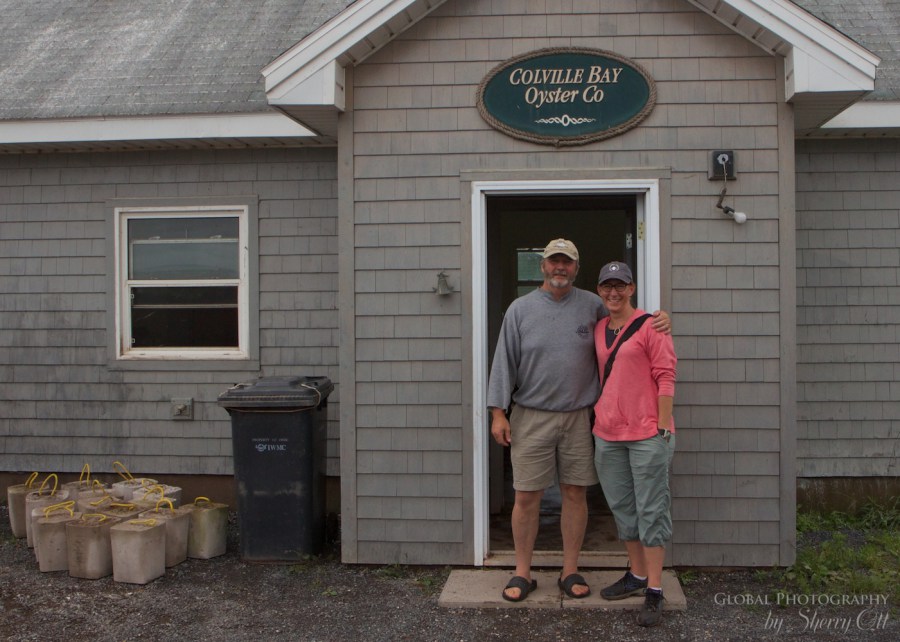
I really like Johnny, he was a small town guy who oozed laid back calm – he definitely seemed like a guy that knew how to go with the flow. I am so enthralled with people like him who take risks and are entrepreneurial in fields that they know little about. It was actually inspiring to listen to him. Even though Johnny didn’t know much about aquaculture, he learned quickly, and after a number of years of time and investment, he had his first ‘crop’ of oysters. I’m quite familiar with agriculture, since my family tree is full of Nebraska farmers, but I had no idea what Aquaculture was. It was hard for me to imagine farming principle applies to the water.
“You don’t have to put up hay or scoop manure,” Johnny replied when I asked him how it was like agriculture, “they (the oysters) take care of themselves, and they take about 5 years to form.”
How to ‘Grow’ Oysters
It all starts with a Chinese Hat – actually a form that looks like an Asian conical hat. They coat the hat form with porridge like mixture of cement and lime and place them in the river. The spat (baby oysters) are drawn to the mixture and fixate themselves to the hat and grow. After 4 months they bring the hats out to dry full of little beginnings of oysters about the size of your fingernail. They crack the hats like it’s an ice cube tray and the little oyster shells fall off.

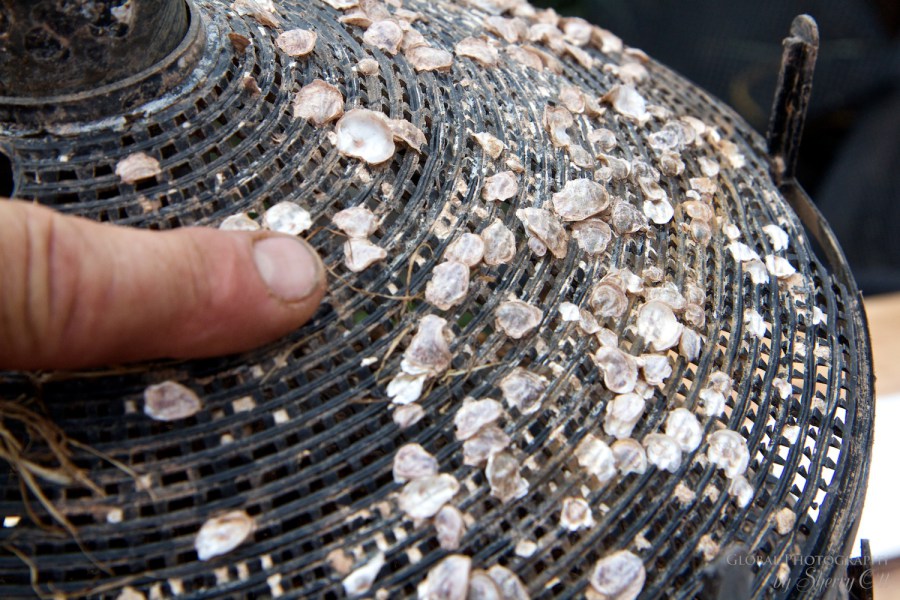
From there they go into French Tables and are placed in the river. No, it’s not dining tables set in the water. French Tables are basically racks or bags that are full of holes and are placed in the water where the tide comes over them, water flows through them, and then lowers leaving them exposed to the air. Johnny said it was like a giant tea bag that allows the water to flow through. Where they are located in Souris River is the key to growing great oysters, as it’s close to the mouth of the ocean so the river undergoes tidal changes and has a mixture of fresh and saltwater. Plus they have a natural sandbar that helps protect the oysters.

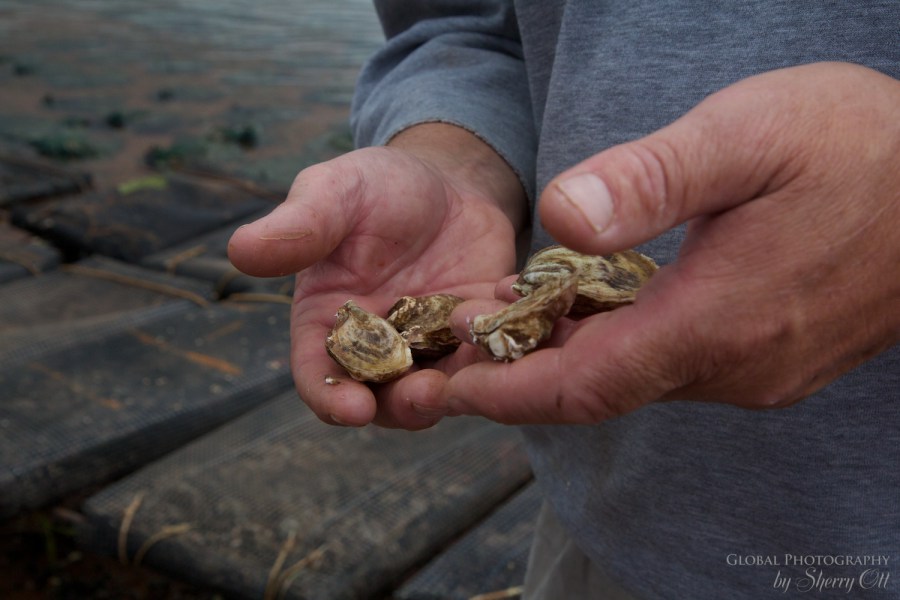
As the oysters grow through the years in the bags, they need to be moved to bigger bags with more space – just like growing kids. I learned pretty quickly that that there is a lot of ‘tending to the crops’ that has to take place. They also go about moving the entire oyster crop each winter to warmer waters in a nearby lake, and then back to Souris River in the summers. The process can take up to 5 years to get the perfect Colville Bay oyster.
They then harvest the crop and pick out the ones that are ready with tongs and move them to the little shack/office where they get ready to be shipped. They are separated, washed, boxed, and shipped all by hand ensuring only the best oysters bear the Colville Bay name.
“I don’t get caught up on the shape of the oyster shell,” Johnny explained while showing us how the separate them, “What’s in between the covers is what’s important.”
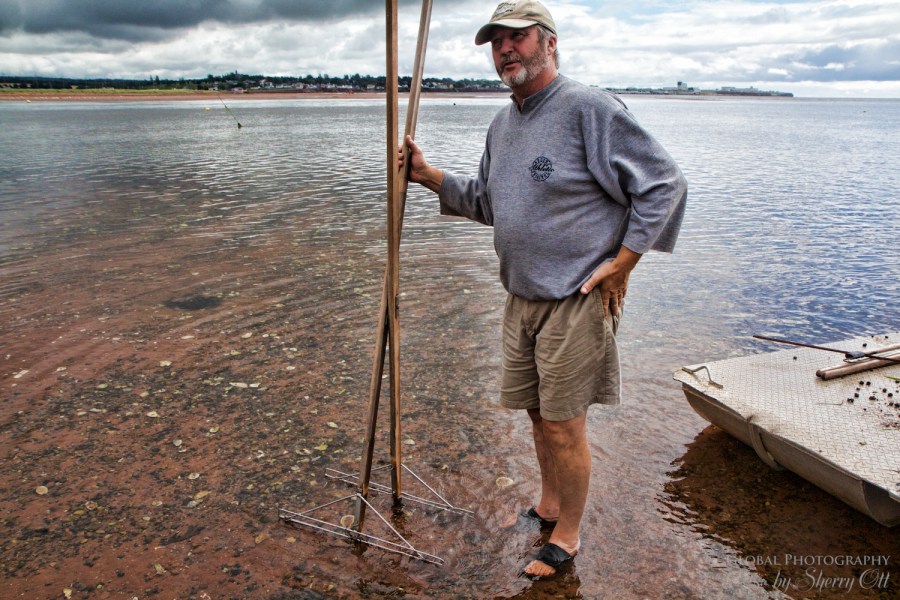
As I slurp down my 3rd oyster for the morning, I’m pretty happy with what’s between the covers. They have a hint of brininess to them, but they also finish buttery sweet. Even though I’m slurping them down for free this morning from the source, you’ll find the Colville Bay oysters on menus mainly in Canada and also in parts of the US. However you can find them for about $1 an oyster all over PEI – which is just another reason to get yourself to this culinary island for a seafood holiday!
Johnny’s son is now studying Aquaculture in university with the desire to work in the business. For a family that knew nothing about oysters when they started, they are in the process of building an oyster empire. As I said goodbye and drove away from the little oyster shack, I looked at the old home where Johnny grew up across the street. Sometimes you really don’t have to go far from home to have wild adventures. Life takes strange twists and turns and you have to let go and just go with them. Sometimes they lead you to great things, great people, and great breakfasts.
Where you can go to find Colville Bay Oysters in PEI:
Johnny and his brother also own a Lobster Shack on the bay in Souris. If you are looking for things to do in PEI it’s a great place to stop for picnic of oysters or lobster near the beach. The “shack” is located on the boardwalk at Souris beach. Specializing in Colville Bay oysters and PEI lobster. Promoting PEI seafood one species at a time!

Sherry Ott is a refugee from corporate IT who is now a long term traveler, blogger, and photographer. She’s a co-founder of Briefcasetobackpack.com, a website offering career break travel inspiration and advice.
Additionally, she runs an around the world travel blog writing about her travel and expat adventures at Ottsworld.com.com.








